
|
| The old mining rigs,
Lucknow |
Lucknow
Historic goldmining village - site of Australia's second
gold discovery
Lucknow is a tiny, former goldmining village located 9 km
south-east of Orange on the Mitchell Highway and 250 km
north-west of Sydney.
The first European in the area appears to have been
Lieutenant Percy Simpson who traversed Frederick's Valley en
route to Wellington where he established a convict
settlement. In 1824 a government station cum garrison was
established in the valley as a resting place for those
travelling to the new penal settlement.
The Lucknow estate was established in 1838 by William
Charles Wentworth, a member of the first European party to
cross the Blue Mountains. The land was then leased to a
Captain Raine.
In May 1851 the estate became the site of the second gold
discovery in Australia, after
Ophir. The usual story is that two tenant farmers found
gold on the hill behind what is now the village. As this was
privately-owned land, Wentworth demanded a monthly fee with
royalties from prospectors. This arrangement only lasted
four months as the royalties became too exorbitant.
In April 1852 the whole estate was sold to the Wentworth
Gold Field Company - the first goldmining company to be
formed in Australia. It went into liquidation in 1860 and
the land was opened to the public on monthly leases in 1862.
The settlement was named 'Lucknow' in 1863. Some say this
was a reference to the good fortune the town proffered
(i.e., luck now) while others claim it was named by the mine
bookkeeper after the siege at Lucknow in India in which he
may have been wounded.
Four hotels were in operation by 1866 as well as a public
school, a Catholic church (1864), a police station and
lock-up, general store, butcher's, blacksmith's, bootmaker's
and baker's. Church services were initially held in a bark
hut which doubled as a school until a National School
building was erected in 1864. Anglican and Wesleyan churches
were erected in 1873 and 1886 respectively.
After initial hardship caused by drought the finds came
thick and fast and substantial fortunes were made. The Bank
of NSW and Commercial Bank purchased 1962 kg of Lucknow gold
from April 1862 to February 1867, though other gold went to
private buyers or direct to Bathurst or Sydney. The largest
nugget weighed 76 kg.
By 1872 the easy pickings were gone and an influx of
capital was needed to extend the mining further underground.
The Uncle Tom Company was formed in 1873 but it ran out of
capital owing to mismanagement and closed. It was purchased
and reopened in 1878 by Henry Newman who had made his
fortune at Lucknow but lost it subsequently. The reopened
mine proved profitable and other companies successfully
worked the fields until the outset of the 20th century.
Most of the land at Lucknow was privately owned by large
syndicates until subdivision commenced in 1913. In 1929 the
Bismarck Group recommenced mining and struck a new vein.
They operated the field successfully until they ran out of
funds in 1937 and there have been no further such
enterprises since that time. It has been estimated that the
fields yielded around 14 000 kg of gold in all.
Things to see:
![[Top of page]](smlArrow.gif)
Tourist Information
Orange Visitors Centre, Civic Square, Byng St, tel: (02)
6361 5226.
Historic Buildings
The bluestone Anglican church was erected in 1873 to replace
a bark hut which doubled as a school and centre for both
Anglican and Wesleyan services from the outset of the town's
establishment. The initial National schoolhouse (1864) blew
down and was replaced with a fine stone building in 1878.
New wooden classrooms, added to the original structure in
1900, became the school when the stone structure was
demolished in 1958. The school ceased operations in 1971 and
is now a community hall.
'Mamhead' was built as the residence of local identity
Henry Newman (see introduction) in 1879, at the rear of his
store. It is an unusual mixture of styles, with rendered
masonry, hipped and gambrel roofs, numerous chimneys
featuring decorative moulding, cast-iron verandah columns
and timber louvred shutters. It is located by the corner of
the main road and Carroll St.
The school of arts was built in 1887 and served as a
library, dance hall, silent movie theatre and general
meeting place. A function for Governor-General Northcote was
held here in 1906 and the Coo-ee marchers from
Gilgandra stopped here during World War I. It is located
on the Mitchell Highway and is currently a garage.

Broadwalk
Business Brokers
Broadwalk Business
Brokers specialise in General Businesses for Sale, Caravan Parks for
Sale, Motels for Sale, Management Rights & Resorts for Sale, Farms for
Sale, Hotels for sale,Commercial & Industrial Properties for Sale.
Phone:
1300 136 559
Email:
enquiries@broadwalkbusinessbrokers.com.au
AUSTRALIAN BUSINESSES FOR SALE
COFFS HARBOUR BUSINESS BROKERS
BROADWALK BUSINESS BROKERS
GOLD COAST BUSINESSES FOR SALE
BRISBANE BUSINESSES FOR SALE
SYDNEY BUSINESSES FOR SALE
CARAVAN PARKS FOR SALE
BUSINESSES FOR SALE
MOTELS
FOR SALE
HOTELS
FOR SALE
Disclaimer
We advise prospective purchasers that we take no
responsibility for the accuracy of any information in the business
provided by vendors or their professional advisers and that they should
make their own enquiries as to the accuracy of this information,
including obtaining independent legal and/or accounting advice
Lucknow

